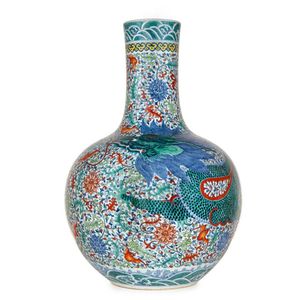Qing Dynasty Dragon Vase with Qianlong Mark
You must be a subscriber, and be logged in to view price and dealer details.
Subscribe Now to view actual auction price for this item
When you subscribe, you have the option of setting the currency in which to display prices to $Au, $US, $NZ or Stg.
- Ming Dynasty - The Ming Dynasty was a ruling dynasty of China from 1368 to 1644. It succeeded the Yuan Dynasty and preceded the Qing Dynasty. The Ming Dynasty was established by Zhu Yuanzhang, a former Buddhist monk who became a rebel leader and eventually overthrew the Mongol Yuan Dynasty. During the Ming Dynasty, China experienced a period of relative stability and prosperity. The government was centralized and bureaucratic, with the emperor at the top of the hierarchy. The Ming Dynasty is known for its cultural achievements, including the development of porcelain, the invention of movable type printing, and the construction of the Great Wall of China.
- Qing Dynasty - The Qing Dynasty was the last imperial dynasty of China, ruling from 1644 to 1912. It was established by the Manchu people, who originated from the northeastern region of China. The Qing Dynasty was preceded by the Ming Dynasty and followed by the Republic of China.
This item has been included into following indexes:
- Chinese ceramics - mallet vase / bottle vase 249
- Chinese ceramics, decoration - blue and white, vases 928
- Chinese ceramics, dynasty mark or period
- Chinese ceramics, famille decoration - famille verte, Wucai, vases 156
Visually similar items

A Zambian emerald and diamond ring, featuring an oval faceted oval emerald of 6.29cts, flanked by heart faceted and round brilliant cut diamonds to the surround and shoulders all totalling 1.25cts, in 18ct white gold, ring size N.

Art Deco platinum emerald & diamond brooch oval design with a central emerald which the valuation States is 2.38ct total weight approximately surrounded by brilliant and single cut diamonds and a border of baguette cut emeralds. Length 51 mm the emeralds a

Good hallmarked silver medallion, hallmarked Birmingham 1920

A Moorcroft limited edition squirrel vase, 1/300. 29 cm high.
